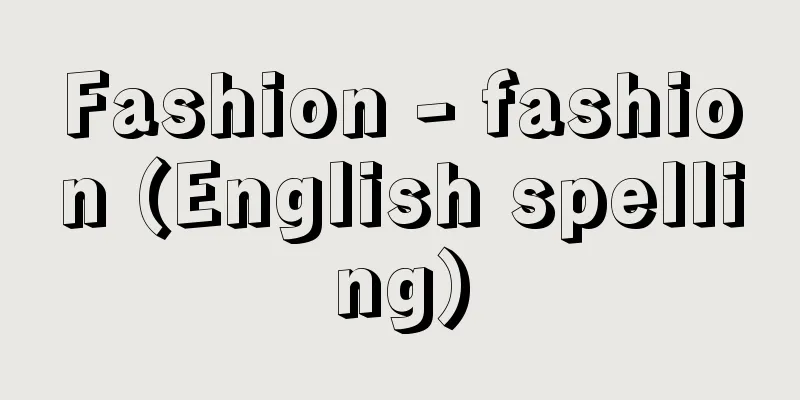Fashion - fashion (English spelling)

|
A general term for the process in which a shared phenomenon based on certain values in various aspects of daily life moves from a small group to a large group at a certain time. In other words, it refers to "trends" that are expressed in intangible things such as ideas, language, and art, as well as lifestyles such as food, clothing, and shelter. However, since "trends" in this sense are generally most evident in clothing, fashion is often translated as "clothing trends." From the perspective of the fashion business, it is used as a synonym for a style that is popular, generally accepted, and worn during a certain period of time, and even clothing itself. [Akiko Fukai] Etymology, synonymsThe word originates from the Latin factio, which means making or finishing. It became the French word façon, and then the English word fashion. Today, the original English word fashion has a variety of meanings. Its primary meaning is "fashion" or "the current style," and in the past it referred to the customs and styles of the upper classes in particular. Secondly, from the original etymological meaning, it can refer to "way," "method," or "style," and it can also mean "making" or "style." In French, mode (moda in Italian, mode in German) is used as a synonym for fashion. Additionally, vogue means trendy in both English and French. Fashionable, which means "trendy," "fashionable," or "sensitive to trends," is a derivative word from fashion, and its French equivalent is à la mode. Additionally, English words that describe relatively short-term trends include fad and boom. Once a trend has spread and lost its freshness, it goes out of style. However, once it becomes established and permanent, it survives as a custom (custom). [Akiko Fukai] The Essence of FashionClothing is originally a part of humans, or something that is one with humans, but before fashion is a personal expression of will, it is, as E. Fuchs puts it, "an expression of the dominant concept of the world," that is, a sign and symbol of society. The essence of fashion lies in this contradiction and conflict between the individual and society. On the one hand, individuals assert themselves and enjoy the courage of change and newness , but on the other hand , they follow conventions and try to conform to society by imitating them, avoiding deviation from society. [Akiko Fukai] Fashion StructurePeople become dissatisfied with ordinary, mundane things, and they wish to break away from them and clarify their own existence. This is the desire for isolation. This leads to a demand for novelty, and fashion is born. This new style is recognized, evokes sympathy under various conditions, and people try to imitate it. When this behavior spreads further, that is, when a desire for association arises, fashion is established. However, once a style becomes a fashion and its adoption spreads, the desire for isolation once again begins to demand the next new style. At this point, the previous fashion goes out of fashion and eventually falls into disuse. G. Simmel sees these two opposing psychological needs as "conformity and isolation," while KG F Lang sees them as "identification and differentiation," and they are considered to be important psychological pillars of fashion. JC Flügel, GALundberg, R. König, and others say that fashion is due to more complex psychological factors than just these two. Furthermore, in addition to being a psychological and sociological subject, when fashion is involved in the distribution process as it is today, attempts are being made to explain its logic from an economic perspective. In addition, Roland Barthes, who analyzed fashion semiotically, in his book The Discourse of Fashion (1967), viewed the structure of fashion on three levels: written costumes, photographed costumes, and costumes actually worn. [Akiko Fukai] Fashion CycleIn any case, fashion can be summarized into a single pattern in that it goes through the following process: emergence → spread/expansion → peak → decline → disappearance. This process is called the fashion cycle. However, fashion is a highly complex social phenomenon, and it is difficult to know the exact length of time (fashion life) from emergence to disappearance of this cycle. Today, the fashion life tends to become shorter every year. [Akiko Fukai] How Fashion WorksHumans are not satisfied when their physiological and physical needs are met, but also seek to satisfy aesthetic, mental, and social needs. In particular, clothing is an expression of the human being, and therefore seeks aesthetic, mental, and social satisfaction. There are countless examples. For example, the hoops (paniers) that stretched skirts excessively in the Rococo period and the unnaturally bent S-shape of the female silhouette in 1900 were clear expressions of the era. In every era, people were convinced that the fashion of that era was the most beautiful and logical expression of clothing. Inactivity, such as ties, narrow tight skirts, high heels, and nylon stockings in winter, still exist today in functionalism. In this way, fashion can be said to be an invigorating agent that stimulates and energizes the spirit, in the sense that clothing is required to have aesthetic, spiritual, and social functions. It tirelessly pursues new styles of beauty. Even if each individual fashion is fickle and frivolous, when people desire it, there is no denying that fashion as a whole has the power to transform society itself and the culture of that society. [Akiko Fukai] The birth of fashionFor fashion to emerge and be born, certain conditions must exist in society. For example, the class systems in ancient and medieval feudal societies restricted life, making it difficult for a desire for self-expression to emerge. Under such circumstances, people live according to tradition and custom, and fashion is unlikely to emerge. However, in modern societies, particularly urban societies, where class systems and status are unclear, new styles are relatively freely adopted. Fashion tends to develop more actively in modern, democratic societies. Economic and time leeway further promote this tendency. Once the minimum material needs for survival are met and daily life has reached a certain level, people become attracted to fashion. Paris - Since the 15th century, under the will of the French government, which had continued to protect fashion as a national industry, Paris inherited the soil that nurtured the artistic sense and advanced techniques to create costumes for the court society that was the driving force of the era, and by the 18th century, Paris had acquired the reputation of "Parisian mode". In the 19th century, haute couture was born by Walt C. Forth, and since then, new trends have been created one after another with the emergence of talented designers such as Poiret, Chanel, Dior, Balenciaga, and Saint Laurent. And even today, with the emergence of mass society since the 1960s, prêt-à-porter has taken the lead in fashion, and it continues to lead the world as the center of fashion. London - Since the 18th century, Paris and London have been rivals in fashion. In the 19th century, Paris, with the beautiful Empress Eugénie (wife of Napoleon III) as its fashion leader, took the lead in women's clothing. Meanwhile, the dandy GB Brummell (1778-1840) appeared in London's high society and had a major impact on men's fashion. Men's clothing, which established a nearly modern style in the 19th century, has since become increasingly strict and precise in its shapes, and London remains its center to this day. [Akiko Fukai] Development of the fashion businessRising incomes, increased leisure time, the spread of education, and the development of transportation and communication systems are major factors that promote fashion. In the 20th century, when these factors were in place, fashion made great strides as an industry in countries other than France. In 1930, Flugel predicted the establishment of today's fashion business, writing in The Psychology of Clothes, "As the expansion of fashion came to include widespread and powerful commercial profits, large industries were established to supply the endless flow of innovative clothing that fashion demanded." New York - Since the mid-19th century, the invention of the sewing machine and the Civil War had already industrialized ready-to-wear men's clothing in America, and from the end of the 19th century to the beginning of the 20th century, the ready-to-wear women's clothing industry grew. Since then, New York, which stands as the economic and cultural center of America, and especially of the world, has followed the global trend of shifting from haute couture to prêt-à-porter and become the largest center of the ready-to-wear industry today. Milan - Milan has been getting a lot of attention in recent years, and since the Renaissance it has been a city that has inherited advanced craftsmanship and artistic sensibility, but due to political reasons such as the delay in the national unification of Italy, it has not been able to assume a leading role as the center of fashion. However, it has been gradually building up its strength as a production base for French fashion, and since the 1970s it has held a collection (Milan Collection), producing original, everyday high-quality fashion and attracting attention. Thus, there are currently several cities in the world that are attracting attention as fashion-producing hubs, taking advantage of the characteristics created by their historical backgrounds and environments. However, with the ever-developing information transmission media, these centers are mutually influencing each other, and fashion is moving in the direction of global uniformity. [Akiko Fukai] The road to becoming fashionable in JapanAlthough the wave of modernization that began after the Meiji Restoration promoted the westernization of Japanese clothing , when we look at women's clothing, it was only adopted for uniforms for nurses and schoolgirls. There is a theory that the Rokumeikan customs were the beginning of Western clothing for Japanese women, but this cannot necessarily be seen as a general phenomenon, since all of these were social clothes for balls and the like, and not everyday clothing. Western clothing as everyday clothing began to be worn by ordinary women from the end of the Taisho era to the beginning of the Showa era (1920s), but it was not until after World War II that it became widely worn in earnest. It was only at this time that Western clothing rapidly took hold, replacing the unique kimono culture that had existed until then. Since the Meiji Restoration, Japan had focused on developing the textile industry, and the groundwork for western clothing had already been laid, ushering in a postwar boom in Western dressmaking. In the 1950s, the rapid development of the textile industry, mainly chemical fibers, made the postwar era of scarce clothing a thing of the past, and in the 1960s, people were guaranteed a rich, physiological and physical clothing lifestyle. The advent of the mass consumer society, the speedup of communication methods, and the increase in leisure time led to a fast-paced lifestyle, and dependence on ready-made clothes became inevitable. Furthermore, as the quality of ready-made clothes improved, people gradually began to demand more diversity in their clothing lifestyle, and interest in fashion suddenly increased. It was around this time that terms such as "fashion industry" and "fashion business" became independent and began to take root. Along with this, various new occupations related to fashion were born, and new foreign words such as coordinator, stylist, illustrator, and buyer were introduced. Today, with the world-class Japanese designers at work, the Japanese fashion industry has become inseparable from popular society, responding to the increasingly diverse nature of clothing. It can be said that fashion in modern life plays a role in providing spiritual fulfillment rather than merely providing physical satisfaction in our clothing needs. [Akiko Fukai] Fashion Industry StructureToday, fashion is made possible by the fashion industry, which is supported by the fields of production, distribution, retail and information. [Akiko Fukai] productionIt is made up of the textile industry, which supplies clothing materials, and the ready-made garment manufacturing industry (apparel industry), which is involved in clothing production. The textile manufacturing industry is sometimes called the primary manufacturer, and the ready-made garment manufacturing industry is sometimes called the secondary manufacturer. [Akiko Fukai] distributionTrading companies, fabric wholesalers, wholesalers, etc. They are involved from the raw materials stage to retail sales, and act as intermediaries between the delivery of yarn, fabric, and secondary products. [Akiko Fukai] retailSelling products directly to consumers, such as department stores, specialty stores (boutiques, etc.), mass retailers, and mail order sales. [Akiko Fukai] informationFashion is accepted and worn by many people. Therefore, producers must always anticipate and predict what will resonate with fashion's recipients in advance at the production stage, and produce based on that. Meanwhile, consumers, who are the source of input, are also seeking new fashion information through a variety of media in a rapidly changing society. In other words, information is exchanged between producers and consumers, and is mutually accepted. For this reason, the fashion industry is an industry that is highly dependent on information. Information includes not only direct information such as the current core fashion products at home and abroad, forecasts of trends in colors, materials, and styles, consumer psychology, market conditions, and the situation at other stores, but also information on art, entertainment, sports, customs, ideology, and political and economic movements that influence fashion. For producers, the key to judging trends is not only to collect this information quickly and abundantly, but also to accurately analyze and select the information that will be used. Therefore, each company has a specialized information gathering and analysis department, and specialized information companies have also been born. On the other hand, the fact remains that consumers are constantly responding to and fascinated by new things in response to rapid changes in fashion. Producers must gain as many supporters as possible for their innovative ideas. For this reason, new fashion information is constantly being reported by specialized fashion magazines and newspapers, as well as general newspapers, magazines, and television. Fashion journalism is involved in reporting these topics. Among these, fashion magazines (fashion books), which first appeared at the end of the 18th century and made great strides in the 19th century, are still an important medium for communicating fashion today. Furthermore, more proactive means such as exhibitions, fashion shows, and advertising also play a major role in communicating fashion. Consumers obtain new fashion information through these various means, but it is only when that information resonates with them that it becomes reality and becomes fashion. [Akiko Fukai] Mode and Fashion Design, edited by Inoue Shun et al. (Iwanami Lecture Series: Contemporary Sociology 21, 1996, Iwanami Shoten) ▽ Simmel, Collected Works of Simmel 7, translated by Maruko Shuhei and Okubo Takeharu (1994, Hakusuisha) ▽ Fukai Akiko, Paris Collection (1994, Kodansha) ▽ Bruno du Roselle La Mode (1980, Imprimerie nationale, Paris) ▽ Roland Barthes, The System of Fashion, translated by Sato Nobuo (1972, Misuzu Shobo) [References] |Source: Shogakukan Encyclopedia Nipponica About Encyclopedia Nipponica Information | Legend |
|
生活行動のさまざまな面で、ある一定の時期に、ある価値観に基づく共有の現象が、少数の集団から多数の集団へと移行していく過程の総称。すなわち、思想、言語、芸術などの無形のものから、衣食住などの生活様式にまで表れる「はやり」のこと。しかし、この意味での「はやり」は、一般には服飾のうえでもっとも顕著にみられるために、ファッションは「服飾流行」と訳される場合が多い。ファッション・ビジネスの立場からは、ある特定の期間において人気を得、一般に受け入れられ着用されたスタイル、さらには、服飾それ自体の同義語としても用いられる。 [深井晃子] 語源、類語作り、できぐあいなどを意味するラテン語ファクティオfactioが語源。フランス語のファソンfaçonとなり、さらに英語のファッションfashionとなった。今日、本来の英語でのファッションには多様な意味がある。第一義は「流行」であり、「はやりの型」であり、以前はとくに上流階級の慣習、様式などをさしていた。第二に、語源本来の意味から「仕方」「方法」「様式」などをさし、さらには「作り」「型」などの意味もある。 ファッションの同義語として、フランス語ではモードmode(イタリア語モーダmoda、ドイツ語モーデMode)を使う。また、ボーグvogueは英語、フランス語ともに流行の意。「流行の」「はやりの」「流行に敏感な」などの意味をもつファッショナブルは、ファッションからの派生語であり、これに相当するフランス語はア・ラ・モードà la modeである。また比較的短期間の流行を表す英語にはファッドfad、ブームboomなどの語がある。流行が行き渡り、新鮮さが失われると流行遅れとなる。しかし、それが定着し、恒続化すると慣習(カスタムcustom)として生き残る。 [深井晃子] ファッションの本質衣装はもともと人間そのもの、もしくは人間と一体のものであるが、ファッションは個人的意思表示である以前に、フックスE. Fuchsがいうように「主調となる世界の概念の表現」、つまり社会の徴表であり、記号である。この個人と社会の矛盾と対立のなかに、ファッションの本質が潜んでいる。個人は自己を主張し、変化や新しさへの勇気を好む半面、慣習に従い、それを模倣することによって社会から逸脱することを避け、社会に順応しようとする。 [深井晃子] ファッションの構造平凡なありふれたもののなかで人は満たされなくなり、そこから脱け出して自己の存在を明確にしたいと願うようになる。孤立化への欲求である。そして新しさが求められ、ファッションが芽生える。この新しいスタイルが認知され、さまざまな条件のもとで共感をよび、人々はこれを模倣しようとする。この行動がさらに拡大していったとき、つまり結合化への欲求がおこったときに、ファッションが成立する。しかし、一つのスタイルがファッションとなり採用者が広がってしまうと、ふたたび孤立への欲求が次の新しいスタイルを求め始める。このときに、先のファッションは流行遅れとなり、やがて廃れていく。 この対立する二つの心理的欲求を、ジンメルG.Simmelは「同調化と孤立化」、ラングK.G.F.Langは「同一化と差別化」としてとらえ、ファッションの重要な心理的支柱としている。これら二つの要因だけではなく、より複雑な心理的要因によるとするのは、フリューゲルJ.C.Flügel、ランドバーグG.A.Lundberg、ケーニッヒR.Königなどである。さらに、こうした心理学、社会学的対象としてのみならず、今日のようにファッションが流通過程に乗った場合では、経済学的見地からの論理解明も試みられている。 また、ファッションを記号学的に分析したロラン・バルトR. Barthesは、『モードの体系』(1967)のなかで、モードの構造を書かれた衣装、写真となった衣装、実際に着用された衣装という三つのレベルでとらえた。 [深井晃子] ファッションの周期いずれにせよ、ファッションは発生→伝播(でんぱ)・拡大→頂点→衰退→消滅というプロセスを通るという点において、一つのパターンに集約できる。このプロセスをファッション・サイクルfashion cycle(ファッションの周期)とよぶ。しかし、ファッションは非常に複合的な社会現象であって、このサイクルの発生から消滅までの、正確な時間的長さ(ファッション・ライフfashion life)を知ることはむずかしい。今日、ファッション・ライフは、年々短縮化傾向をたどっている。 [深井晃子] ファッションの働き人間は生理的、物理的欲求が満たされれば、それで満足するものではなく、美的、精神的、社会的欲求も満たそうとする。とりわけ衣装は、人間そのものの表現ともいえるものであるからなお、美的、精神的、社会的充足感を求める。その具体例は、枚挙にいとまがないほどである。たとえばロココ時代の極端にスカートを張らせたフープ(パニエ)も、1900年のS字型に不自然に曲げられた女性シルエットも、その時代性の明確な表現なのであった。どの時代にも、その時代におけるファッションを人々はもっとも美しく、かつまたもっとも論理的な衣装表現であると確信していた。ネクタイ、狭いタイト・スカート、ハイヒール、冬のナイロンストッキングなどの非活動性は、機能主義の今日にもまぎれもなく存在している。 このように、もともと美的、精神的、社会的機能が強く求められる服飾において、ファッションは精神に刺激を与え、活性化させる活性剤なのだといえよう。それは、飽くことなく新しい美のスタイルを追い求める。個々のファッションが、気まぐれで軽薄なものであっても、人々がそれを望むとき、ファッションは全体として社会そのもの、そして社会の文化を変貌(へんぼう)させる力をもつものであることを否定することはできない。 [深井晃子] ファッションの誕生ファッションの発生と誕生には、社会の側にそれなりの条件が備わっていなければならない。たとえば、古代社会や中世封建社会における階級制は生活を規制するので、自己表現への欲求は芽生えにくい。このような状況のもとでは、人々は伝統、慣習に従って生活し、ファッションは生まれにくい。ところが階級制や身分のあいまいな近代社会、とくに都市社会においては、新しいスタイルは比較的自由に取り入れられる。ファッションは、近代的・民主的社会においてより活発に展開する傾向がみえる。経済的、時間的余裕は、さらにこの傾向を促進する。生命を維持するための最低物資が充足され、日常生活がある水準に達した段階で、人々はファッションの魅力にとらえられる。 パリ――すでに15世紀以来、国家的産業としてファッションを保護し続けたフランス政府の意向を受け、時代の担い手となった宮廷社会の衣装を創作する芸術的感覚と高度な技術とをはぐくむ土壌を受け継いだパリは、18世紀までに「パリ・モード」の名声を手中にしていた。19世紀になるとウォルトC.F.Worthによりオートクチュールhaute-coutureが誕生し、以来ポワレ、シャネル、ディオール、バレンシアガ、サン・ローランなど、才能あふれるデザイナーたちの登場によって次々と新しい流行が生み出された。そして1960年代以降の大衆社会の出現によって、プレタポルテprêt-à-porterがファッションの主導権をとるようになった今日も、ファッションの中心地として、常に世界をリードし続けている。 ロンドン――18世紀以来、パリとロンドンはファッションのライバルとして競い合ってきた。19世紀になると、美貌(びぼう)のユージェニー皇后(ナポレオン3世の皇后)をファッション・リーダーに擁したパリが婦人服ではリードを奪う。一方、ロンドンの社交界には伊達男(だておとこ)とうたわれたブランメルG.B.Brummell(1778―1840)が登場し、メンズ・ファッションに大きな影響を与えた。19世紀にほぼ近代的様式が確立された紳士服は、以後、しだいに形の厳しさと正確さとを増し、ロンドンはその中心地として今日に至っている。 [深井晃子] ファッション・ビジネスの発展収入の増加、余暇の増大、教育の普及、交通・輸送・伝達機関などの発達は、ファッションを促進させる大きな要因である。フランス以外の各国でも、これらの要因が整った20世紀になって、ファッションは産業として飛躍的な発展をみせた。フリューゲルは、1930年に「ファッションの拡大による広範で強力な商業的利潤が含まれてくると、大産業が、ファッションの要求する斬新(ざんしん)な衣服の絶えまない流れを補うために確立されてくる」(The Psychology of Clothes)と、今日のファッション・ビジネスの成立を予言している。 ニューヨーク――すでに、19世紀なかば以来、ミシンの発明と南北戦争とにより、紳士用既製服を産業化したアメリカでは、同末期から20世紀初めにかけて、婦人用既製服産業が成長した。以来、アメリカ、とりわけ世界の経済・文化の中心地という背景にたつニューヨークは、オートクチュールからプレタポルテへと移行していた世界的趨勢(すうせい)に従って今日の既製服産業最大の中心地となっている。 ミラノ――近年とくに話題にのぼるミラノは、ルネサンス以来、綿々と高度な職人的技術と芸術的センスを受け継いできたが、イタリアの国家的統一の遅れなど政治的事情により、ファッションの中心地として主導的立場にたつまでには至らなかった。しかし従来から、フランス・ファッションの生産基地として徐々に力を蓄えていたこともあり、1970年代以降、コレクション(ミラノ・コレクション)を開催し、独自のかつ、日常的高品質ファッションを生み出し、注目を浴びるようになった。 このように現在世界には、歴史的背景と環境がつくる特徴を生かしながら、ファッションを生み出す核として注目されているいくつかの都市がある。しかし、今後ますます発達する情報伝達メディアにより、これらの中心地は相互に影響を与えあい、ファッションは世界的に均一化の方向へ向かっている。 [深井晃子] 日本のファッション化への道明治維新以来の文明開化の波は、日本人の洋装化を促進させたとはいえ女子服に限ってみると看護婦、女学生などの制服に取り入れられたのみであった。鹿鳴館(ろくめいかん)風俗が日本女性の洋装の始まりだとする説があるが、これらがすべて舞踏会などのための社交服であり、日常の生活服ではなかったという点で、かならずしも一般的な現象とはとらえられない。日常服として、いわゆる洋服は、大正の終わりから昭和の始め(1920年代)にかけて一般女性にも着られるようになったが、本格的に広く着られるようになるのは、第二次世界大戦後のことであった。このときようやく、それまでの独自の着物文化にかわって、急激に洋服が浸透する。明治維新以来、繊維産業の発展に力を注いできた日本には、すでに洋装化への下地が固まっており、戦後の洋裁ブーム時代が到来することになるのである。 昭和30年代になると、化学繊維を中心とする繊維産業の飛躍的発展によって、戦後の乏しい衣料時代はすでに過去のものとなり、昭和40年代は、生理的、物理的には豊かな衣生活が保証されていく。また、大衆消費社会の到来、伝達方法のスピード・アップ、余暇時間の増大は、テンポの速い生活様式を出現させ、既製服への依存は避けられないこととなった。さらに、既製服の質的向上に伴って、しだいに衣生活には多様性が要求されるようになり、ファッションへの関心がにわかに高まった。「ファッション産業」「ファッション・ビジネス」などの用語が独立し、定着し始めたのはこのころであった。これに伴い、ファッションに関連するさまざまな新しい職種が生まれ、コーディネーター、スタイリスト、イラストレーター、バイヤーなどといった新しい外来語も導入された。 今日では、世界的レベルの日本人デザイナーが活躍し、日本のファッション産業は、ますます多様化する衣生活に対応しつつ、大衆社会と切り離すことのできないものとなった。現代生活のなかでのファッションは、われわれの衣生活を物理的に充足するという意味以上の精神的充足の役割を担っている、ということができる。 [深井晃子] ファッション産業の機構今日、ファッションは、ファッション産業によって成立する。これを支えるのは、生産、流通、小売り、情報の各分野である。 [深井晃子] 生産衣服素材を供給する繊維産業と、衣服生産に携わる既製服製造産業(アパレル産業)とによって成り立っている。繊維製造業を一次メーカー、既製服製造業を二次メーカーとよぶこともある。 [深井晃子] 流通商社、生地問屋、卸売業者など。原料段階から小売りまでの間に介在し、糸や生地、二次製品を渡す仲立ちをする。 [深井晃子] 小売り消費者に直接商品を販売する分野。百貨店、専門店(ブティックなど)、量販店、通信販売など。 [深井晃子] 情報ファッションは多くの人々に受け入れられ、着用されるものである。したがって生産者側は、つねにファッションの受け手が何に共感をもつかを、生産段階であらかじめ察知し、予測し、それに基づいて生産しなければならない。一方、着手(きて)である消費者もまた、急速に変化する社会のなかで、さまざまな媒体を通じて、新しいファッションの情報を求めている。すなわち情報は、生産者と消費者の相互から発せられ、相互に受け入れられるという関係にある。このため、ファッション産業は、情報に強く依存する産業なのである。 情報とは、国内外での今現在のファッションの中心的商品をはじめとし、色、素材、スタイルの傾向予測、消費者心理、市況、他店状況などの直接的情報はもちろんのこと、ファッションに影響を及ぼす芸術、芸能、スポーツ、風俗、思想、政治・経済の動きなど、すべてがファッション情報となりうる。生産者にとっては、これらを敏速、豊富に収集することとともに、情報の的確な分析と取捨選択が傾向判断の重要な鍵(かぎ)となる。したがって各企業では、専門の情報収集、分析部門を備えており、また、専門の情報会社も生まれている。 一方、消費者は、ファッションの急速な変化に応じて、つねに新しいものに反応し、心を奪われるという事実が、厳然と存在している。そして、生産者は斬新(ざんしん)なアイデアにできるだけ多くの賛同者を得なければならない。このため新しいファッション情報は、専門のファッション雑誌や新聞、あるいは一般の新聞、雑誌、テレビなどによって刻々報道される。これらの報道に携わるのがファッション・ジャーナリズムである。 なかでも、18世紀末に誕生し、19世紀に飛躍的発展を遂げたファッション雑誌(ファッション・ブック)は、今日もなおファッション伝達の重要な媒体である。さらに、ファッションの伝達には、より積極的手段である展示会、ファッション・ショー、広告なども大きな役割を担っている。これらの多様な伝達によって消費者は、新しいファッションの情報を得るのであるが、それが共感をよぶものであるときに初めて、情報は現実となり、ファッション化していく。 [深井晃子] 『井上俊他編『モード・ファッション・デザイン』(『岩波講座 現代社会学21』・1996・岩波書店)』▽『ジンメル著、円子修平・大久保健治訳『ジンメル著作集7』(1994・白水社)』▽『深井晃子著『パリ・コレクション』(1994・講談社)』▽『Bruno du RoselleLa Mode(1980, Imprimerie nationale, Paris)』▽『ロラン・バルト著、佐藤信夫訳『モードの体系』(1972・みすず書房)』 [参照項目] |出典 小学館 日本大百科全書(ニッポニカ)日本大百科全書(ニッポニカ)について 情報 | 凡例 |
<<: Fashion industry - Fashion industry
Recommend
Kim History
One of the Twenty-Four Histories, an official hist...
Administrative Agreement under Article III of the Security Treaty between Japan and the United States of America
An agreement between the governments of Japan and ...
Gyokuu - empty space
...Ichi-nen-gi holds that one can attain rebirth ...
Bundestag
...It is usually composed of elected representati...
Five-Power Constitution - Gokenkenpo
Principles of government organization proposed by...
Sea robin
...They use their swim bladders to make sounds li...
Sea stone - Kaijōkoku
…A type of miscellaneous tax in early modern Japa...
Kashan (English spelling)
A city in the southeastern part of Markazi Provinc...
Audio notes - Onsei Hoki
…For example, the character shaped like the sun i...
Bomarzo Gardens
Located in the small town of Bomarzo, 60km north o...
Prionodon pardicolor (English name) Prionodonpardicolor
… Civet cat [Tadaaki Imaizumi]. . . *Some of the ...
Neisse [river] - Neisse
A tributary of the Oder (Odra) River between Polan...
Daedalus - Daidalos (English spelling)
An exceptional craftsman who appears in Greek myt...
Quantum optics
A field of study that discusses the generation mec...
Rakusho-Kan - School custody
...A place for studying Tang music and music from...









